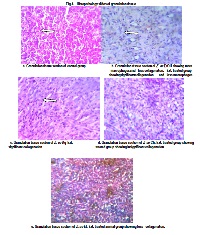Evaluation of wound healing potential of crude extracts of zyziphus oenolpia l. Mill (indian jujuba) in wistar rats
Keywords:
Zyziphus oenoplia, wound models, Drug formulationAbstract
Zyziphus oenoplia is a perennial shrub used in traditional medicine for treating hyper acidity, Ascaris infection, stomachalgia and healing of wounds. The objective of this study was to investigate the root extracts of this plant, to evaluate their wound healing potential in rats. Excision, Incision and Dead space wound modals were used to evaluate the wound healing activity of the extracts on wister rats. In each modal, animals were divided into six groups of six animals. Each model, group I & II served as control and reference standard. In wound models, group III, IV, V and VI animals were treated with plant root extracts (300 and 400mg/kg/day) for 18 days and 10days respectively. The vehicles effect on the rate of wound healing were assessed by the wound closure rate, epithelialisation period, tensile strength, granulation tissue weight, hydroxyproline content and histopathology of granulation tissue. The ethanol extract of plant root promoted wound healing activity significantly in all the wound modals. High rate wound contraction (P<0.001), decrease in the epithelialisation period (14.67±0.33), high skin breaking strength (501.53±2.18g), significant increase in granulation tissue weight (P<0.001) and hydroxyproline (P<0.001) content were observed in ethanol root extract. Histological studies of the granulation tissues of the ethanolic extract treated group showed the lesser number of inflammatory cells, and increase collagen formation than the control and also compared with other groups. Phytoconstituents like flavanoids, alkaloids, steroids, triterpenoids, saponins etc were also confirmed by phytochemical test. The data obtained in this investigation indicated that the ethanolic root extract possesses better wound healing activity and it can treat different types of wounds in human being too.
References
. Gillitzer R, Goebeler M. Chemokines
in cutaneous wound healing. J
Leukoc Biol 2001; 69:513-21.
. Kirtikar KR, Basu. B.D. Indian
Medicinal plants. vol-1, 2nd ed.
Delhi: Periodical Experts Book
Agency; 1991. p- 595.
. Cassels BK, Eckhardt G, Kaussmann
EU, Tschesche R. Cyclopeptide
alkaloids of Zyziphus oenoplia.
Tetrahedron. 1974; 30: 2461-66.
. Yoganarasimhan SN. Medicinal
Plants of India. vol-1. Karnataka:
Interline Publishing Pvt. Ltd; 1996.
p- 524.
. Rastogi RP, Mehrotra BN.
Compendium of Indian Medicinal
Plants. vol-2. Lucknow, New Delhi:
p-723-24.
. Rajakaruna N, Harris CS. Towers
GHN. Antimicrobial Activity of Plants
Collected from Serpentine Outcrops
in Sri Lanka. Pharm Bio. 2002 ; 40:
– 44.
. Suksamrarn S, Suwannapoch N,
Aunchai N, Kuno M, Ratananukul P,
Haritakun R et al, Ziziphine N, O, P
and Q, New Antiplasmodial
Cyclopeptide Alkaloids from
Ziziphus oenoplia var. brunoniana.
Tetrahedron. 2005; 61: 1175-80.
. Yesodharan K, Sujana KA.
Ethnomedicinal knowledge among
Malamalasar tribe of Parambikulam
wildlife Sanctuary, Kerala. Ind J
Trad Know. 2007; 6 : 481-85.
. Hossan Md. Hanif S, AJ,
Rahmatullah Md. R. Medicinal
plants used by the Chakmas,
Bangladesh for gastrointestinal
disorders. Ethnobotany 2008;15:47-
. Kokate C.K. Practical
Pharmacognosy. 4th ed. Vallabh
prakashan. 1997; p. 53, 123-27.
. Wallis TE. Text Book of
Pharmacognosy. Delhi: CBS
Publisher and Distributor. 1985.
p.104-14.
. khandalwal K.R. Practical
Pharmacognosy – Techniques and
experiments. 19th ed. Nirali
Prakashan. 2008; p. 149-56.
. Ghosh, MN. Fundamentals of
Experimental Pharmacology. 2nd
ed. Calcutta: Scientific Book
Agency; 1986. p.156.
. Indian pharmacopoeia. 1966; p.
. Morton JJ, Malone MH. Evaluation
of vulnerary activity by an open
wound procedure in rats. Arch. Int.
Pharmacodyn. Ther. 1972; 196:
-26.
. Dutta HS, Shankar KM, Bhushan P.
Wound healing activity of topical
application forms based on
Ayurveda. Oxfo J, Evidence Based
Comp and Alt Med. 2009.
. Enrlich HP, and Hunt TK. Effect of
cortisone and vitamin A on wound
healing. Anal of Sur. 1968; 167:
-328.
. Lee KH. Studies on the mechanism
of action of Salicylates IIRetardation of wound by aspirin. J
Pharm Sci. 1968; 57: 1042- 43.
. Kuppast IJ, Kusum S. Akki, PV,
Hukkeri VI. Wound healing
activity of Polianthes tuberose bulb
extracts. Ind J Nat Prod. 2006; 22
:10-13.
. Neuman PE,Logan MA. The
determination of collagen and
elastin in tissues. J Biochem.1972;
:549.
. Mukherjee KL. Medical laboratory
Technology. New Delhi: McGraw-Hill
Ltd. 2000.
. Mohan H. Text book of Pathology,
th ed. New Delhi: Jaypee Brother
Medical Publishers (P) Ltd; 2006. P.
-6.
. Nayak BS, Anderson M, Pereira
LMP. Evaluation of wound- healing
potential of Catharanthus roseus
leaf extract in rats. Fitoterapia
; 78: 540-44.
. Sharma S, Sikarwer MS. Wound
healing activity of ethanolic extract
of leaves of Eclipta Alba.
Pharmacog Mag 2008; 4.
. Tsuchiya H, Sato M, Miyazaki T,
Fujiwara S, Tanigaki S, Ohyama M
et al, Comparative study on the
antibacterial activity of
phytochemical flavanones against
methicillin resistant Staphylococcus
arureus. J Ethnopharmacology
; 50: 27-34.
. Getie M, Gebre MT, Reitz R,
Neubert RH, Evaluation of release
profiles of flavonoids from topical
formulations of the crude extract of
the leaves of Dodonea viscosa
(Sapindaceae). Pharmazia 2002;
: 320-22.
. Scortichini M, Pia RM. Preliminary
in vitro evaluation of the
antimicrobial activity of terpenes and
terpenoids towards Erwinia
amylovora (Burrill). J App Bacteriol
;71: 109-12.



